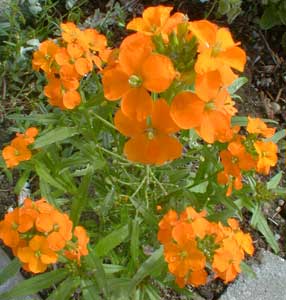
Orange English Wallflower
"Why this flower is now call'd so,
List, sweet maids, & you shall know.
Understand this firstling was
Once a brisk & bonnie lass,
Kept as close as Danae was:
Who a sprightly spring all lov'd,
And to have it fully prov'd,
Up she got upon a wall,
Tempting down to slide withal:
But the silken twist untied,
So she fell, and, bruis'd, she died.
Love, in pity of the deed,
And her loving-luckless speed,
Turn'd her to this plant we call
Now the flower of the wall."
-Robert Herrick
(1591-1674)
(1591-1674)
Although frequently carried in garden catalogs as Cheiranthus, the current genus name is Erysimum. Erysimum cheiri is a hardy biennial or tender perennial here in Zone 8, but would be an annual in cooler climates, easily grown from seed or from cuttings. In our zone, if it is protected from too much summer heat, it may return for more than two years running, but is at best a short-lived perennial, vigorous for its short life, renewable from cuttings.
 It is compact, one to two feet tall, very floriferous from April to July, covered with bright orange phlox-like blooms with excellent perfume.
It is compact, one to two feet tall, very floriferous from April to July, covered with bright orange phlox-like blooms with excellent perfume.Erysimum cheiri is commonly called English Wallflower because long naturalized in England & associated with ruins of old castles where it can literally grow on walls, or on limestone cliffs. Yet it is not in fact native to England; it originated in the eastern Mediterranean region, hence alternatively known as the Aegean Wallflower. It was brought to the British Isles as a gardened medicinal as early as the Norman Conquest, & naturalized in England, Scotland, & Ireland.
It has acquired a litany of other common names including Cheiry of Keiry, Bee Flower, Heart's Ease, Yellow Violet, or Yellow Sweet William. It was Yellow Stock Gilloflower because the flowers were as sweetly scented as gillyflowers (carnations).
The former genus name Cheirianthus now still serves as a secondary common name. It means "Handflower," a name conferred upon it because it was carried in the hand during medieval festivals. The species name reiterates the genus name, but is also related to the medieval common name Chevisaunce or Cherisaunce, which means "Comfort," perhaps because of its medicinal properties if not merely because its scent & beauty are comforting.
Although it prefers neutral to alkaline soils, ours grow in unamended acidic soil & do fine. Although a feeding of lime is often recommended, we haven't bothered to change the soil for its benefit. Some wood-ash from the fireplace or a stick of chalkboard chalk inserted into the roots might be appreciated, but I haven't wanted to tinker with the soil for so long as the clump is doing so well.
They need well-draining soil & don't like excessive wetness, but are not as drought-hardy as E. linefolium, needing periodic watering especially at high summer, as it will lose vigor during extended hot periods. It prefers full sun but will get by in partial shade.
The Greek physician Galen believed this wallflower was useful for regulating the menstrual cycle, to relieve pain of childbirth, for liver & kidney problems, & to clear cataracts. It had centuries for alleged medicinal values to mount up. The plant does in fact contain cardiac glycosides called cheiranthosides, similar to digitalis, which can have pretty intense effects on the body, potentially curative presuming its toxicity didn't merely kill the user. Its modern use as an herbal remedy is rare, due to its dangerousness.
Long a symbol of doomed lovers & of faithfulness in advedrtisty, legend has it that a certain Elizabeth the daughter of the Earl of March in 14th Century Scotland, dropped a wallflower from her father's castle window as a signal to her lover that she was willing to elope with the son of King Robert III, her father's foe.
Her father, angered by her choice for dalliance, imprisoned her in Neidpath Castle. The prince, disguised as a minstrel, waited near the castle wall for his beloved's signa, when to his delight the flower fell nearby. But Elizabeth while attempting to climb down from Neidpath Castle fell to her death. The young prince left Scotland & as a grief-stricken wandering minstrel throughout Europe, keeping always a sprig of wallflower in his cap.
The same symbolic meaning of doomed love is captured in the poem by Herrick quoted above, which has the dead beloved herself transformed into a wallflower.